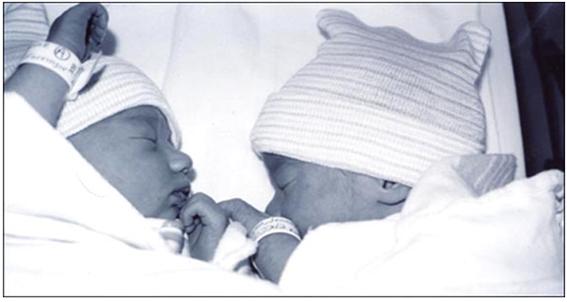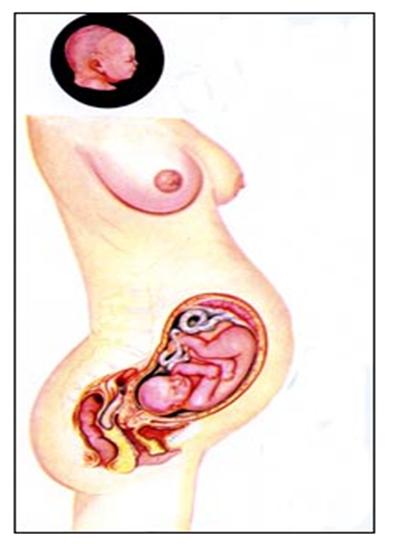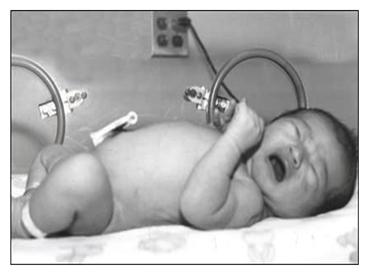신생아기, 신생아, 신생아 집중치료실, Neonatal period, Newborn infants, Newborn infant special care center

사진1.갓 태어난 예쁘고 건강한 쌍둥이 신생아.
Copyright ⓒ 2011 John Sangwon Lee, MD., FAAP
신생아를 잘 보살피고 양육하려면 부모들도 신생아는 무엇이고 신생아기는 무엇인지 그 정의를 알아두는 것이 좋다.
- 태어난 이후부터 생후 28일까지의 기간을 신생아기라 한다.
- 때로는 생후부터 첫 1개월까지 기간을 신생아기라고도 한다.
- 그 신생아기에 속한 아기들을 신생아들이라고 한다.
- 신생아들은 의학적인 면에서 볼 때 다른 성장기에 있는 아이들에 비해 다른 점이 참말로 많이 있다.
- 수정란이 자궁 내벽에 착상된 바로 그 때부터 임신 8주까지 배아라고한다.
- 그 이후부터 출생할 때까지 자궁에서 자라는 아기를 태아라고 한다.
- 태아는 모체로부터 산소, 영양분 등을 전적으로 공급받고, 외부에서 오는 유해로부터 보호받고 모체에 전적으로 의존하면서 약 2백 80일 동안 자궁 속에서 성장 발육하다 태어난다.
- 자궁 내에서는 모체에 100% 의존해서 성장 발육하던 태아가 태어나자마자 신생아 자신이 숨을 쉬고 독립된 한 인간으로 살아가야 한다.
- 자신의 호흡기계, 심장 혈관계, 소화기계, 비뇨생식기계, 신경계, 면역계 등의 기능에 의해 살아야한다.
- 부모나 보호자가 주는 영양분을 받아먹고 그 영양분을 에너지 자원으로 쓰면서 성장 발육한다.
- 자신이 가지고 있는 신체의 모든 기관들이 정상적으로 기능해야 이 세상을 정상적으로 살아갈 수 있다.
- 이렇게 살아가는 동안 그들에게 끊임없이 각종 질병과 사고 등이 닥쳐온다.
- 각종 질병과 사고들 중 어떤 것은 신생아들의 건강과 생명에 위협을 줄 수 있다.
- 그들은 그런 위협에 도전하면서 살아가야 한다.
- 통계에 의하면, 태어나서부터 첫 돌까지 아기들의 사망의 70%가 신생아기에 생긴다.
- 선천성 기형, 선천성 질병, 또는 출생 후 생긴 질병 또는 안전사고 등으로 인해 신생아가 신생아기간 동안에 사망하지 않으면 신생아기 이후에는 사망할 가능성은 아주 적어진다.
- 태아는 태반을 통해 모체로부터 각종의 영양분과 산소를 전적으로 공급받고, 태아에서 생성된 노폐물은 태반을 통해 모체로 운반되고 결국에는 모체에서 배설된다.
- 태어나자마자 신생아들은 자신이 가지고 있는 신경계, 심장 혈관계, 호흡기계, 비뇨생식기계, 소화기계, 내분비계, 면역체계 등 모든 기관들이 정상적으로 기능해야 정상적으로 산다고 위에서 이미 언급했다.
- 신생아의 신체의 여러 계통에 있는 각종 기관들 중 하나나 둘, 또는 그 이상 어떤 기관에 이상이 있으면 그 신생아는 때로는 사망할 수 있고, 사는 동안 평생 불구자가 될 수 있고, 또 일생 동안 고생하면서 살게 된다.
- 예를 들면, 심한 선천성 심장 기형, 분만 중 심한 뇌 손상, 분만 중 산소 결핍증 등으로 생긴 뇌성마비 또는 신생아 질식 등으로 신생아가 신생아기에 사망할 수 있고 불구자가 될 수 있고, 그로 인해 일생 동안 고생하면서 살 수 있다.
- 아주 작은 저 체중 미숙 신생아들의 일부는 최신 의학기술로 최선을 다해 치료받아도 생존할 수 없다. 가진 노력으로 생존할 수 있어도 일생 동안 불구자로 살 수 있다.
- 신생아는 모체로부터 면역체를 정상적으로 어느 정도 받아가지고 태어난다. 거기다가 태여난 후 바로 신생아 자신의 면역체계의 기능이 발육되기 시작한다. 그렇지만 신생아기 동안 신생아들은 세균 감염에 저항하는 능력이 미약해서 감염병에 걸리기 쉽다.
- 신생아의 한 국소에 박테리아 감염이 생기면 그 박테리아가 아주 짧은 시간 내 전신에 퍼져 신생아 패혈증 및, 또는 신생아 뇌막염 등 생명을 위협할 수 있는 위중한 감염병에 쉽게 걸릴 수 있다. 그리고 신생아기 이후 소아들에 비해 훨씬 더 심하게 앓을 수 있고, 또 더 쉽게 사망하기도 한다.
- 일반적으로 신생아에게 생긴 박테리아 감염병의 증상 징후는 신생아기 이후 아기들에게 생긴 박테리아 감염병의 증상 징후에 비해서 더 심하게 나타날 수 있다.
- 이런 저런 이유로 신생아들의 성장 발육, 양육, 질병 등을 특별히 전문으로 하는 신생아 소아과학이 생기고 그를 전문으로 하는 신생아 전문의도 생겼다.
- 신생아 전문의는 신생아들에 관련된 양육, 건강, 질병, 예방 등 신생아들의 전체 건강 문제를 전문적으로 신속하게 해결할 수 있게 연구했다. 그들은 일반 소아 청소년과학을 전문한 후 거기다가 신생아들의 성장 발육, 질병 등 신생아 의학을 더 특별히 더 공부하고 더 연구하고 더 전문한다.
- 요즘은 각 나라와 그 지방의 의료실정에 맞게 신생아 집중치료실이 거의 모든 큰 종합병원에 있다. 거기서 그 주위나 지방의 신생아의 건강 문제를 필요에 따라 집중적으로 진단, 치료, 예방하게 됐다.
- 신생아들의 질병과 건강문제를 전문적으로 효과적으로 특별하게 해결 할 수 있는 신생아 집중치료실(Newborn infant special care unit)의 가치와 효과는 아주 지대하다.
- 거기서 신생아들에 생긴 질병 등을 보다 쉽고 빠르게 진단 치료할 수 있게 됐다. 그리고 신생아의 건강 문제를 특별히 신속히 진단 치료할 때 필요로 하는 신생아 특수 의료 장비도 구비되고 설치되어 있다. 거기서 종사하는 의료 보조인들도 신생아 집중치료실을 효과적으로 운영할 수 있게 특별히 교육 받고 전공하고 공부한다.
- 특수 신생아 집중치료실이나 특수 신생아 병원에는 신생아과 전문의, 신생아 의학 전문 간호사, 신생아 보조 의료요원 등이 신생아 건강 문제에 적절히 대처할 수 있도록 하루 24시간 일년 365일 동안 항상 대기하고 있다.
- 필요할 때마다 신생아 건강문제를 가장 효과적으로 해결해 준다.
- 그 지방에 있는 소아 청소년과 전문의들에게 있을 수 있는 신생아 문제를 해결해 주는데도 도움을 주고 있다.
- 요즘 세계 각 나라에서는 신생아학과 전문의, 신생아과 전문 간호사, 신생아과 보조 의료요원 등으로 구성된 신생아 집중 치료팀과 신생아 특수 수송 구급차가 필요에 따라 먼 지방에까지 파견된다.
- 그 시골 현장에서 신생아과 전문의와 간호사 등이 신생아의 건강 문제를 응급으로 치료하기 시작한다. 그 결과에 따라 큰 종합병원에 있는 신생아 집중 치료실로 그 신생아를 이송하는 의료제도도 있다.
- 신생아에게 병이 나거나 건강 문제가 생기면 대개의 경우, 단골 소아청소년과 전문의 진단 치료를 우선 적절히 받는다. 필요에 따라 단골 소아청소년과 전문의 소개로 신생아과 전문의의 진단 치료를 우선적으로 받아야 할 때도 있다.

그림 2.자궁 내 태아.
Copyright ⓒ 2011 John Sangwon Lee, MD., FAAP

사진 3.인큐베이터 속에 있는 갓 태어난 신생아.
Copyright ⓒ 2011 John Sangwon Lee, MD., FAAP

사진 4.신생아에게 병이 났을 때 신생아 집중치료실로 이송할 수 있는 특수 신생아 구급차. 신생아의 질병이나 건강 문제를 응급으로 치료 할 수 있는 의료인들이 구급차 내에서도 신생아 질병을 치료 할 수 있고. 또 필요한 의료장비도 신생아 구급차 내에 설치되어 있다. 마치 이동할 수 있는 신생아 집중 치료실이 구급차 내에 있는 것과 같다.
Copyright ⓒ 2011 John Sangwon Lee, MD., FAAP
Neonatal period, Newborn infants, Newborn infant special care center신생아기, 신생아, 신생아 집중치료실

Picture 1. A beautiful and healthy newborn twin. Copyright ⓒ 2011 John Sangwon Lee, MD., FAAP
- In order to take good care of and nurture a newborn, it is good for parents to know what a newborn baby is and what is newborn baby care.
- The period from birth to 28 days after birth is called the newborn period.
- Sometimes the period from birth to the first month is called the newborn period. The babies in that newborn period are called newborns.
- In terms of medicine, newborns have a lot of differences compared to children in other growth stages.
- It is said to be an embryo from the very time the fertilized egg is implanted on the inner wall of the uterus until the 8th week of pregnancy.
- A baby that grows in the womb from then to birth is called a fetus.
- The fetus is born after growing and developing in the womb for about 280 days while being fully supplied with oxygen and nutrients from the mother, protected from external harmfulness, and completely dependent on the mother. In the womb, the newborn must breathe and live as an independent human as soon as a fetus that has grown and developed 100% dependent on the mother is born.
- You must live by the functions of your own respiratory system, cardiovascular system, gastrointestinal system, genitourinary system, nervous system, and immune system.
- Newborns receive and eat nutrients from parents or guardians and grow and develop by using those nutrients as energy resources.
- All organs in the body that newborns have must function normally in order to live in this world normally. While living like this, various diseases and accidents constantly come upon them.
- Some of the various diseases and accidents can endanger the health and life of newborns. They have to live by challenging those threats.
- According to statistics, 70% of babies’ deaths from birth to their first birthday occur in the neonatal period. If the newborn does not die during the neonatal period due to congenital malformations, congenital diseases, or postnatal illness or safety accidents, the likelihood of dying after the neonatal period is very small.
- The fetus is fully supplied with various nutrients and oxygen from the mother through the placenta, and waste products produced in the fetus are transported to the mother through the placenta and are eventually excreted from the mother.
- As soon as they are born, it has been mentioned above that newborns live normally only when all organs, including their nervous system, cardiovascular system, respiratory system, genitourinary system, digestive system, endocrine system, and immune system, function normally. If one, two, or more of the organs of the newborn’s body are abnormal, the newborn can sometimes die, be crippled for life during life, and suffer for life.
- For example, severe congenital heart anomalies, severe brain damage during delivery, cerebral palsy caused by oxygen starvation during delivery, or asphyxiation of newborns can cause the newborn to die in the neonatal period and become disabled.
- Some of the very small, low-weight, immature newborns cannot survive even with the best treatment with the latest medical technology.
- Even if newborns can survive with the hard work newborns have, newborns can live the disabled for a lifetime. Newborns are born with some degree of immune system normally received from the mother. In addition, immediately after birth, the function of the newborn’s own immune system begins to develop.
- However, during the neonatal period, newborns are susceptible to infectious diseases due to their poor ability to resist bacterial infection.
- When a bacterial infection occurs in one area of a newborn baby, the bacteria can spread throughout the body within a very short period of time, making it easy to get serious, life-threatening infectious diseases such as neonatal sepsis and neonatal meningitis.
- And after the neonatal period, children can get sick much more severely and die more easily than children. In general, the symptoms of a bacterial infection in newborns may be more severe than the symptoms of a bacterial infection in babies after the neonatal period.
- For these and other reasons, neonatal pediatrics specializing in the growth, development, rearing, and disease of newborns was created, and neonatal specialists specializing in it were also created.
- The neonatal specialist has researched to quickly and professionally solve the entire health problems of newborns, including parenting, health, disease, and prevention related to newborns.
- After specializing in general pediatric and adolescent science, they study more specifically, study more, and specialize more in neonatal medicine, such as growth and development of newborns and diseases.
- These days, neonatal intensive care units are located in almost all large general hospitals to suit the medical conditions of each country and region.
- From there, they intensively diagnosed, treated, and prevented the health problems of newborns around or in the region as needed.
- The value and effectiveness of the Newborn Infant Special Care Unit, which can professionally and effectively solve the diseases and health problems of newborns, are very significant.
- There, it became possible to diagnose and treat diseases in newborns more easily and quickly. In addition, special medical equipment for newborns, which is required for rapid diagnosis and treatment of newborns’ health problems, is also equipped and installed.
- Medical assistants engaged there are also specially educated, majored, and studied so that they can effectively operate the neonatal intensive care unit. In special neonatal intensive care units or special neonatal hospitals, neonatal specialists, neonatal medicine nurses, and neonatal assistant medical personnel are always on standby 24 hours a day, 365 days a year to adequately cope with newborn health problems.
- Whenever necessary, it most effectively solves the newborn’s health problems.
- The local pediatric and adolescent specialists are also helping to solve newborn problems that may exist. Nowadays, in each country of the world, neonatal intensive care teams consisting of neonatal specialists, neonatal specialist nurses, neonatal medical assistants, etc., and special transportation ambulances for newborns are dispatched to remote regions as needed. In the rural scene, newborns, specialists and nurses begin to treat the newborn’s health problems as an emergency.
- As a result, there is also a medical system that transports the newborn to the neonatal intensive care unit in a large general hospital. If a newborn is sick or has a health problem, in most cases, a regular pediatrician is treated appropriately first. If necessary, it may be necessary to first receive diagnostic treatment from a neonatal specialist through the introduction of a regular pediatrician.

- Figure 2. Fetus in the womb. Copyright ⓒ 2011 John Sangwon Lee, MD., FAAP

- Picture 3. A newborn baby in an incubator. Copyright ⓒ 2011 John Sangwon Lee, MD., FAAP

Photo 4: A special newborn ambulance that can be transported to the newborn intensive care unit when a newborn baby is sick.
Medical professionals who can treat a newborn’s illness or health problem in an emergency can treat newborn ailments even in an ambulance.
In addition, necessary medical equipment is also installed in the newborn ambulance.
It’s like having a mobile newborn intensive care unit in an ambulance. Copyright ⓒ 2011 John Sangwon Lee, MD., FAAP
출처 및 참조 문헌
- NelsonTextbook of Pediatrics 22ND Ed
- The Harriet Lane Handbook 22ND Ed
- Growth and development of the children
- Red Book 32nd Ed 2021-2024
- Neonatal Resuscitation, American Academy Pediatrics
- www.drleepediatrics.com 제1권 소아청소년 응급 의료
- www.drleepediatrics.com 제2권 소아청소년 예방
- www.drleepediatrics.com 제3권 소아청소년 성장 발육 육아
- www.drleepediatrics.com 제4권 모유,모유수유, 이유
- www.drleepediatrics.com 제5권 인공영양, 우유, 이유식, 비타민, 미네랄, 단백질, 탄수화물, 지방
- www.drleepediatrics.com 제6권 신생아 성장 발육 육아 질병
- www.drleepediatrics.com제7권 소아청소년 감염병
- www.drleepediatrics.com제8권 소아청소년 호흡기 질환
- www.drleepediatrics.com제9권 소아청소년 소화기 질환
- www.drleepediatrics.com제10권. 소아청소년 신장 비뇨 생식기 질환
- www.drleepediatrics.com제11권. 소아청소년 심장 혈관계 질환
- www.drleepediatrics.com제12권. 소아청소년 신경 정신 질환, 행동 수면 문제
- www.drleepediatrics.com제13권. 소아청소년 혈액, 림프, 종양 질환
- www.drleepediatrics.com제14권. 소아청소년 내분비, 유전, 염색체, 대사, 희귀병
- www.drleepediatrics.com제15권. 소아청소년 알레르기, 자가 면역질환
- www.drleepediatrics.com제16권. 소아청소년 정형외과 질환
- www.drleepediatrics.com제17권. 소아청소년 피부 질환
- www.drleepediatrics.com제18권. 소아청소년 이비인후(귀 코 인두 후두) 질환
- www.drleepediatrics.com제19권. 소아청소년 안과 (눈)질환
- www.drleepediatrics.com 제20권 소아청소년 이 (치아)질환
- www.drleepediatrics.com 제21권 소아청소년 가정 학교 간호
- www.drleepediatrics.com 제22권 아들 딸 이렇게 사랑해 키우세요
- www.drleepediatrics.com 제23권 사춘기 아이들의 성장 발육 질병
- www.drleepediatrics.com 제24권 소아청소년 성교육
- www.drleepediatrics.com 제25권 임신, 분만, 출산, 신생아 돌보기
- Red book 29th-31st edition 2021
- Nelson Text Book of Pediatrics 19th- 21st Edition
- The Johns Hopkins Hospital, The Harriet Lane Handbook, 22nd edition
- 응급환자관리 정담미디어
- Pediatric Nutritional Handbook American Academy of Pediatrics
- 소아가정간호백과–부모도 반의사가 되어야 한다, 이상원 저
- The pregnancy Bible. By Joan stone, MD. Keith Eddleman, MD
- Neonatology Jeffrey J. Pomerance, C. Joan Richardson
- Preparation for Birth. Beverly Savage and Dianna Smith
- 임신에서 신생아 돌보기까지. 이상원
- Breastfeeding. by Ruth Lawrence and Robert Lawrence
- Sources and references on Growth, Development, Cares, and Diseases of Newborn Infants
- Emergency Medical Service for Children, By Ross Lab. May 1989. p.10
- Emergency care, Harvey Grant and Robert Murray
- Emergency Care Transportation of Sick and Injured American Academy of Orthopaedic Surgeons
- Emergency Pediatrics A Guide to Ambulatory Care, Roger M. Barkin, Peter Rosen
- Quick Reference To Pediatric Emergencies, Delmer J. Pascoe, M.D., Moses Grossman, M.D. with 26 contributors
- Neonatal resuscitation Ameican academy of pediatrics
- Pediatric Nutritional Handbook American Academy of Pediatrics
- Pediatric Resuscitation Pediatric Clinics of North America, Stephen M. Schexnayder, M.D.
-
Pediatric Critical Care, Pediatric Clinics of North America, James P. Orlowski, M.D.
-
Preparation for Birth. Beverly Savage and Dianna Smith
-
Infectious disease of children, Saul Krugman, Samuel L Katz, Ann A.
- 제4권 모유, 모유수유, 이유 참조문헌 및 출처
- 제5권 인공영양, 우유, 이유, 비타민, 단백질, 지방 탄수 화물 참조문헌 및 출처
- 제6권 신생아 성장발육 양호 질병 참조문헌 및 출처
- 소아과학 대한교과서
|
Copyright ⓒ 2015 John Sangwon Lee, MD., FAAP 미국 소아과 전문의, 한국 소아청소년과 전문의 이상원 저 “부모도 반의사가 되어야 한다”-내용은 여러분들의 의사로부터 얻은 정보와 진료를 대신할 수 없습니다. The information contained in this publication should not be used as a substitute for the medical care and advice of your doctor. There may be variations in treatment that your doctor may recommend based on individual facts and circumstances. “Parental education is the best medicine.” |